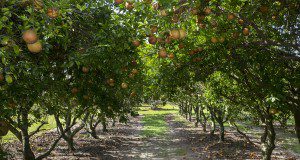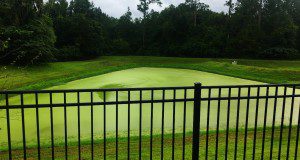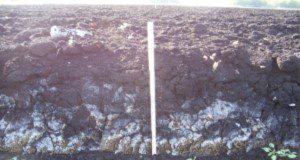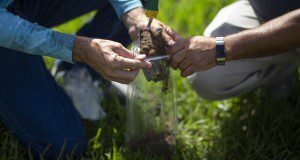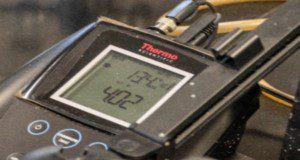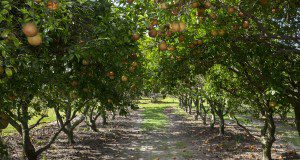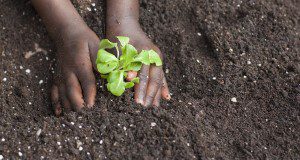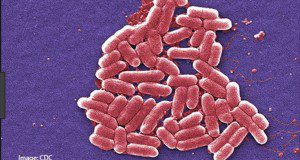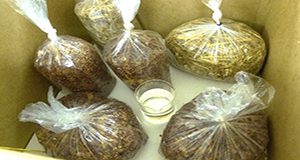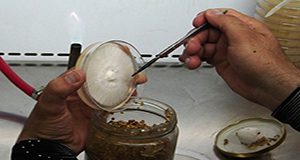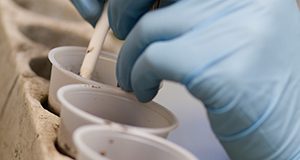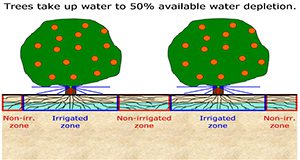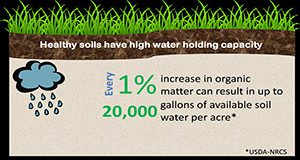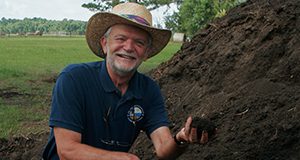This update to 2007’s second edition adds information regarding nutrition of Florida citrus trees affected by huanglongbing (HLB), also known as citrus greening. Much of the guidance provided in this document on nutrients, application methods, leaf and soil sampling, and irrigation scheduling is also effective for trees affected by HLB. However, research conducted since the previous edition was published has established changes in many production practices, including nutrient rates, irrigation scheduling, soil pH management, and use of Citrus Under Protective Screen (CUPS). Changes to the second edition will appear at the beginning of chapters 2, 6, 8, 9, and 11. See also this topic page for links to individual chapters in HTML and PDF formats. This 115-page book was edited by Kelly T. Morgan and Davie M. Kadyampakeni, and published by the UF/IFAS Department of Soil and Water Sciences.
https://edis.ifas.ufl.edu/ss478
Tag: Department of Soil and Water Sciences
Sources and Transformations of Nitrogen in Urban Landscapes
With 80% of Florida’s residents living within 10 miles of the coast, Florida’s aquatic resources are directly affected by urbanization. The intent of this new 6-page publication of the UF/IFAS Department of Soil and Water Sciences is to describe the urban nitrogen cycle for a nontechnical audience. Ultimately, this document is intended for individuals working in urban environments and concerned about nutrient pollution and water quality issues, but do not have a technical background and want to improve their understanding of nitrogen cycling. Written by Alexander J. Reisinger, Mary G. Lusk, and Ashley R. Smyth.
https://edis.ifas.ufl.edu/ss681
How to Properly Dispose of Unwanted Medications
Properly disposing of expired or unused medications can help reduce the prevalence of prescription drug abuse in Florida. It also helps prevent accidental ingestion by children or pets, helps prevent accidentally taking the wrong medication, and prevents medications from entering water sources. This new 3-page publication of the UF/IFAS Department of Soil and Water Sciences provides some dos and don’ts for disposing of your medications. Written by Alexander J. Reisinger.
https://edis.ifas.ufl.edu/ss680
Everglades Agricultural Area Soil Subsidence and Sustainability
This 4-page major revision, a publication of the UF/IFAS Department of Soil and Water Sciences, highlights the current status of Histosols within the Everglades Agricultural Area in southern Florida. Over the last century, soils within the region have gradually been lost via oxidation, a process commonly referred to as soil subsidence. The rate of subsidence is gradually declining, due to factors such as increased mineral content in soil, humification, and water management (maintenance of higher water tables). Best Management Practices and crop rotation help slow down the rate of oxidation and promote soil sustainability within the region. Written by Jehangir H. Bhadha, Alan L. Wright, and George H. Snyder.
https://edis.ifas.ufl.edu/ss523
Soil Sampling Procedures
To achieve optimal grove nutrition, citrus growers must test grove soil before beginning any fertilization program. Standard procedures for sampling, preparing, and analyzing soil should be followed for meaningful interpretations of the test results and accurate recommendations. This new two-page fact sheet, published by the UF/IFAS Department of Soil and Water Sciences, provides illustrated soil sampling procedures and tables to aid in basic interpretation of lab results. Written by Davie Kadyampakeni, Kelly Morgan, Arnold Schumann, and Rhuanito S. Ferrarezi.
https://edis.ifas.ufl.edu/ss667
Citrus Soil pH Testing Procedures
Maintaining the correct soil pH is essential to ensure optimal plant growth and crop yield. This new two-page document is an instructional sheet for citrus soil pH testing, written by Kelly Morgan and published by the UF/IFAS Department of Soil and Water Sciences.
https://edis.ifas.ufl.edu/ss665
Citrus Soil pH Management
Management of both soil pH and nutrients is required to maintain soil fertility levels and ensure economic agricultural production. Maintaining soil in the 6.0-6.5 pH range is best for most crops including citrus. This new two-page publication of the UF/IFAS Department of Soil and Water Sciences, written by Kelly Morgan, explains the effects of soil pH on citrus as well as options for management.
https://edis.ifas.ufl.edu/ss666
Soils and Fertilizers for Master Gardeners: Soil Physical Characteristics
Soils are a foundational component of the landscape, providing a medium for plant root growth and playing a crucial role in nutrient cycling and water movement across the landscape. This new 7-page article describes the physical properties of soils, including soil formation in Florida, the soil profile, and water dynamics within soils, and provides a thorough reference for Master Gardeners and other individuals searching for a basic understanding of soil dynamics to apply to residential landscapes. Written by Amy L. Shober, Alexander J. Reisinger, Mary G. Lusk, and Sally Ann Scalera and published by the UF/IFAS Department of Soil and Water Sciences.
https://edis.ifas.ufl.edu/mg458
The Importance of Soil Health in Residential Landscapes
This 6-page publication’s purpose is to educate master gardeners and homeowners about the principles of soil health as well as practices that harm or nurture soil health at the residential scale. It also includes a description of the soil food web and the microorganisms that comprise it. This new publication of the UF/IFAS Department of Soil and Water Sciences was written by Sally Scalera, Alexander J. Reisinger, and Mary Lusk.
http://edis.ifas.ufl.edu/ss664
D.I.Y. FunGuide: Grow Your Own Oyster Mushrooms at Home
Oyster mushrooms are commonly found on hardwoods throughout the north temperate zone; they are edible and have many nutritious qualities. This 5-page document describes how you can grow your own oyster mushrooms at home. Written by Chih-Ming Hsu, Khalid Hameed, Van T. Cotter, and Hui-Ling Liao and published by the UF/IFAS Department of Soil and Water Sciences, January 2018.
http://edis.ifas.ufl.edu/ss662
Isolation of Mother Cultures and Preparation of Spawn for Oyster Mushroom Cultivation
This 6-page publication details the cultivation of oyster mushrooms from mother culture isolation to spawn preparation. This protocol can be used by both homeowners and commercial cultivators. Written by Chih-Ming Hsu, Khalid Hameed, Van T. Cotter, and Hui-Ling Liao and published by the UF/IFAS Department of Soil and Water Sciences, January 2018.
http://edis.ifas.ufl.edu/ss663
UF/IFAS Standardized Nutrient Recommendations for Vegetable Crop Production in Florida
Soil testing is a scientific tool for effective nutrient management that provides an estimate or an index of the available nutrient-supplying capacity of the soil. This 9-page publication presents the fertilization recommendations for vegetable crops based on soil tests performed by the IFAS Extension Soil Testing Laboratory (ESTL). Written by Rao Mylavarapu, George Hochmuth, and Guodong Liu and published by the UF/IFAS Department of Soil and Water Sciences, December 2017.
http://edis.ifas.ufl.edu/cv002
Irrigation Management of HLB-Affected Trees
Water is a limiting factor in Florida citrus production due to non-uniform rainfall distribution and the low water-holding capacity of our sandy soils. Because periods of low rainfall coincide with critical stages of citrus production, additional irrigation is necessary to reduce the negative effects of water stress. This 6-page document covers recent findings on water use of trees affected by citrus greening and the impact this would have on irrigation management considerations. Written by Davie Kadyampakeni, Kelly Morgan, Mongi Zekri, Rhuanito Ferrarezi, Arnold Schumann, and Thomas A. Obreza and published by the UF/IFAS Department of Soil and Water Sciences, October 2017.
http://edis.ifas.ufl.edu/ss659
Raising Soil Organic Matter Content to Improve Water Holding Capacity
Just like a sponge, soils with high organic matter (OM) can absorb and hold water during rainfall events and deliver it to plants during dry spells. Water is increasingly becoming the most limited natural resource supporting agriculture, but growers can improve their water storage capacity by raising their soil’s OM content. This 5-page fact sheet demonstrates how soil OM content can help increase water holding capacity of soils and describes the laboratory procedure to measure WHC. Written by Jehangir H. Bhadha, Jay M. Capasso, Raju Khatiwada, Stewart Swanson, and Christopher LaBorde, and published by the UF/IFAS Department of Soil and Water Sciences, October 2017.
http://edis.ifas.ufl.edu/SS661
Soil Testing and Interpretation for Florida Turfgrasses
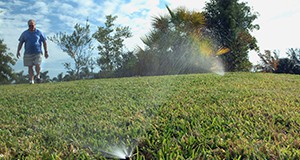
Most people agree that healthy, well-maintained turfgrass is a thing of beauty. The successful growth of turfgrass is aided by having knowledge of a few basic facts concerning the nutritional requirements of turfgrasses and the properties of fertilizer and liming materials. This four-page document will help the reader understand how soil testing may be used to more efficiently manage nutrient applications for Florida turfgrasses. Written by T.W. Shaddox and J.B. Sartain and published by the UF/IFAS Department of Soil and Water Sciences, October 2017.
http://edis.ifas.ufl.edu/SS317
Tools for Evaluating Soil Health
Soil health is a term synonymous with soil quality. It refers to the chemical, biological, and physical characteristics that influence a soil’s ability to function sustainably and to satisfy the needs of humans, support plants, and cycle elements, water, and energy between earth systems. This four-page fact sheet identifies ways to evaluate soil health. Written by Jehangir H. Bhadha, Jay Capasso, Robert S. Schindelbeck, and Allan R. Bacon and published by the Department of Soil and Water Sciences.
http://edis.ifas.ufl.edu/ss657
Parameters for Site-Specific Soil Phosphorus Loss Modeling from Soil Test Data
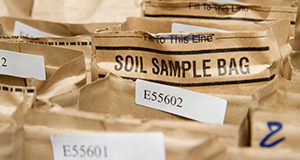
This four-page fact sheet is part of a series titled Soil Phosphorus Storage Capacity (SPSC) for Phosphorus Risk Assessment and Management. This series is intended for use by those who are interested in management practices and policies that minimize the risk of phosphorus loss from soils. Written by Biswanath Dari, Vimala D. Nair, and Willie G. Harris and published by the Department of Soil and Water Sciences.
http://edis.ifas.ufl.edu/ss656
Utilization of Biosolids in Forage Production Systems in Florida
This four-page publication provides basic information about land application of biosolids to pastures and hayfields in Florida. The information contained in this document should be of interest to stakeholders, biosolids managers, students, and scientists interested in topics related to biosolids management practices and the potential benefits and risks associated with biosolid land application. Written by Maria L. Silveira, George A. O’Connor, and Joao M.B. Vendramini and published by the Department of Soil and Water Sciences.
http://edis.ifas.ufl.edu/ss658
Agricultural Soils of Florida
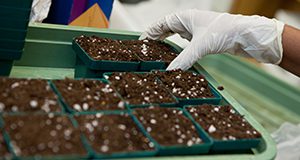
This seven-page fact sheet describes the various soil Orders in Florida, how they were developed, their characteristics, coverage in the state, and uses. This information is important for educating land owners, decision-makers, and educators about soils in Florida, leading to better soil management for agricultural and environmental sustainability. Written by Rao Mylavarapu, Willie Harris, and George Hochmuth and published by the Soil and Water Sciences Department.
http://edis.ifas.ufl.edu/ss655
Trends in Rice Production and Varieties in the Everglades Agricultural Area
Rice production in the Everglades Agriculture Area (EAA) of Florida dates back nearly seven decades. For a brief period in the 1950s about 2,000 acres of rice was grown in the EAA. Rice was reintroduced in the EAA in 1977 after it was demonstrated that rice could be successfully incorporated into the sugarcane production cycle during the fallow period. This three-page fact sheet provides a history of rice production in Florida and information about rice varieties grown in Florida. Written by Jehangir H. Bhadha, Luigi Trotta, and Matthew VanWeelden and published by the Soil and Water Sciences Department.
http://edis.ifas.ufl.edu/ss653
